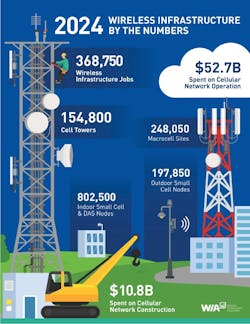The Need for Legislation for Broadband and Wireless Infrastructure Permitting
With mobile data demand rising and 5G rollout accelerating, the Wireless Infrastructure Association calls for comprehensive legislation to fix the fragmented permitting process—and protect connectivity’s future.
In today’s rapidly evolving digital landscape, the demand for robust and reliable wireless communication infrastructure has never been greater. As we continue to witness the proliferation of smartphones and IoT devices and the advent of 5G technology, including fixed wireless access (FWA), the importance of wireless infrastructure and its efficient deployment becomes paramount.
Over the past decade, the permitting process for towers has been greatly improved, supported by the regulatory actions taken by the Federal Communications Commission (FCC). However, recent court rules make any federal-level agency actions less certain, and the process of obtaining permits for new towers and colocating equipment on existing towers continues to face challenges within some jurisdictions. As a result, the Wireless Infrastructure Association (WIA) is calling for comprehensive legislation to streamline and facilitate wireless deployment.
Challenges in Cell Site Permitting
The communications industry works every day to deploy infrastructure that supports mobile and fixed connectivity across the country. In doing so, we’ve become well-acquainted with the complex web of local, state and federal regulations that is the permitting process in many locations today. Local governments absolutely have a role to play in siting wireless infrastructure, but permitting regulations can vary significantly from one jurisdiction to another, leading to inconsistencies and delays in the deployment process. Additionally, the lack of standardized procedures across different regions can result in inefficiencies and increased costs, which ultimately cost all of us who use the networks.
Enshrining key FCC rules into the statute is a critical objective.
This is an everyday, lived experience for those working on the frontlines to ensure Americans stay connected, as well as making sure that the industry can continue to meet the ever-increasing demands for data placed on networks today. There are now over 12.5 million fixed wireless subscribers, and according to Ericsson, total mobile data traffic is estimated to grow threefold between the end of 2023 and the end of 2029.
The good news is that over the last 10 years, the FCC has adopted orders that support the speedy deployment of communications networks with predictable, proportionate and transparent permitting processes. These rules have been a catalyst for the explosive deployment of broadband and 5G access across the United States. For example, in the two years after the FCC’s 2018 Small Cell Order, investment in wireless infrastructure surpassed the previous seven years combined, and more than half of the cell sites currently in service were deployed after the FCC adopted siting reforms. By the end of 2024, just over 651,000 structures supported wireless infrastructure across the US, according to WIA’s recent Wireless Infrastructure by the Numbers report.1 (See Figure 1.)
Still, some local governments have refused to follow these orders, delaying deployment and resulting in time- and capital-intensive challenges. Worse, some federal judges have elected not to follow the directives of the FCC’s rules and have more latitude to make their own non-standardized rules under new precedents, injecting more uncertainty into the process. Enshrining key FCC rules into the statute is a critical objective.
Legislative Solutions
To address these challenges, there is a pressing need for legislation that standardizes and streamlines the wireless infrastructure deployment processes. Ensuring a predictable, proportionate and transparent permitting process that respects state and local review must be a priority for Congress and state legislatures to achieve the goal of providing broadband access to all Americans. Such legislation should aim to provide:
- Clear Timelines: Enshrine existing FCC orders into law at the federal and state levels, providing predictable timelines for application processes, including “shot clocks” on permit applications for wireless facilities, providing timelines for deciding upon an application, and “deemed granted” relief where an authority fails to act on the application in the given time. If the answer is no, tell us and we can work to fix it! This maintains a role for municipalities but gives them a deadline and provides industry with certainty, resulting in quicker connectivity for communities.
- Reasonable Fees: Fees charged for applications must be calculated based on actual costs, established in advance and publicly disclosed. This creates certainty among all parties.
- Streamlined Site Upgrading: Codify FCC rules that allow existing sites to expand the compound by up to 30 feet and add reasonable additional equipment cabinets and antennas without going through further review processes. The structure already exists, and adding new facilities is often the least intrusive means of siting new infrastructure.
- Streamlined Environmental and Historic Review: Establish shot clocks for applications on federally managed lands and recognize where environmental and historic reviews would be unnecessary, such as in disaster recovery areas and previously disturbed Rights of Way.
American Broadband Deployment Act
The most important step Congress and the Trump Administration can take is to reintroduce and enact the American Broadband Deployment Act (ABDA). ABDA is a legislative package from the last Congress that would codify several major permitting reforms enacted by the FCC and right-size federal rules for broadband permitting on federal lands to spur deployment. ABDA would carefully balance and respect the important role of localities in maintaining the aesthetics, character and safety of their community while also ensuring the timely deployment of needed infrastructure.
Beyond codifying FCC orders on infrastructure deployment, ABDA takes proactive steps to improve siting on federal lands and reduce unnecessary red tape for applications to deploy or improve communications networks. If enacted, this bill would ensure that all communities have consistent rules for siting infrastructure, speeding deployment and reducing overall costs for consumers.
WIA is actively working on the Hill to advance these policies.
Local governments absolutely have a role to play in siting wireless infrastructure.
State Legislation
Across the country, WIA is working hand-in-hand with states to also codify the FCC’s orders for broadband deployment at the state level, with recent success in West Virginia and Colorado. Similar to ABDA, these bills provide clear and consistent guidelines for the permitting process, reducing ambiguity and ensuring that all stakeholders understand the requirements, timelines and fees.
Encouraging collaboration between local governments, telecommunications companies and other stakeholders can lead to more efficient and effective deployment strategies. State legislation is aimed at fostering partnerships and open communication channels to address concerns and find mutually beneficial solutions. Several more states are considering permitting legislation, and WIA will continue to work closely with states through the remainder of the 2025 legislative sessions.
Conclusion
At WIA, our goal is to help establish the best business and regulatory environment possible to help our members meet the mission of enabling connectivity everywhere. For permitting, this means we need predictable, proportionate and transparent processes. A consistent permitting framework set at a national level but flexible enough to accommodate local needs and interests is the key to sustained success for wireless infrastructure deployment.
REFERENCE
1. WIA’s Wireless Infrastructure By the Numbers: 2024 Key Statistics, https://wia.org/wireless-infrastructure-by-the-numbers-2024/
About the Author

Mike Saperstein
Chief Strategy Officer and Senior Vice President for Government Affairs, Wireless Infrastructure Association (WIA),
Mike Saperstein is the Chief Strategy Officer and Senior Vice President for Government Affairs for the Wireless Infrastructure Association (WIA), which represents the businesses that build, develop, own, and operate the nation’s wireless infrastructure. WIA advocates for the widespread, responsible deployment of wireless infrastructure to enable connectivity everywhere. For more information, visit www.wia.org. Follow WIA on LinkedIn and X.

